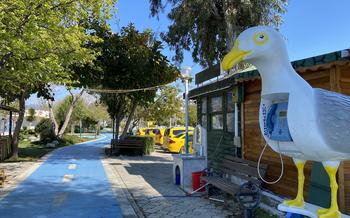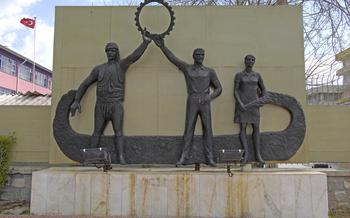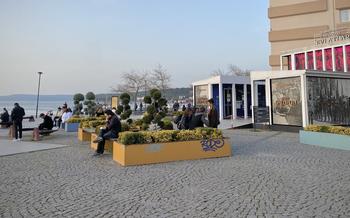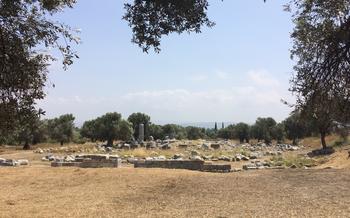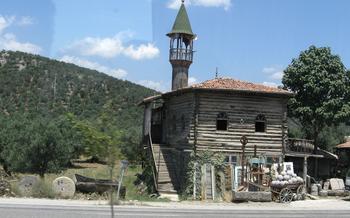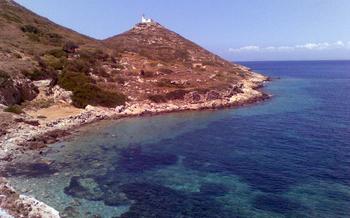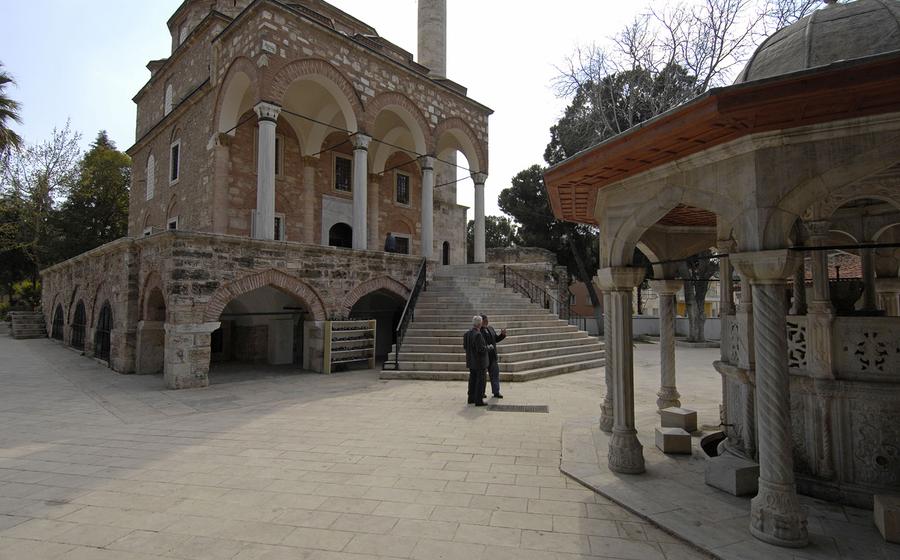
Alabanda Ancient City
- Historical Background:
- Architectural Wonders:
- Religious Sites
- Daily Life and Economy
- Water Systems and Engineering
- Fortifications and City Walls
- Trade and Commerce:
- Cultural Influences
- Natural Surroundings
- Modern-Day Alabanda
- Visiting Alabanda
- Photography Tips
- Insider Tip: Discover the Enchanting Cave of Alabanda
Historical Background:
Alabanda, an ancient city of great significance, was founded in the 4th century BC by Mausolus, satrap of Caria. The city flourished during the Hellenistic period, becoming a prominent center of culture and trade. Under Roman rule, Alabanda maintained its importance and served as the capital of the Cibyratis region. The city's strategic location on the trade routes connecting the Aegean Sea with the interior of Anatolia contributed to its prosperity. Alabanda was renowned for its impressive architecture, religious sites, and vibrant cultural life. Notable historical figures associated with the city include the philosopher and orator Heraclides and the physician Menecrates, who was known for his expertise in treating eye diseases. Alabanda's unique history, influenced by various cultures, sets it apart from other ancient cities and makes it a fascinating destination for history enthusiasts.
Architectural Wonders:
Alabanda boasts an array of impressive architectural marvels that showcase the city's grandeur and artistic prowess. Among these architectural gems are the well-preserved remains of the Temple of Apollo, a majestic structure that once served as the religious center of the city. Its towering columns, intricate carvings, and elegant design reflect the architectural influences of the Hellenistic period.
Another architectural highlight is the Theater of Alabanda, a magnificent structure that could accommodate up to 5,000 spectators. Its well-crafted stage, intricate acoustics, and impressive seating arrangement provide a glimpse into the city's vibrant cultural life. Performances of Greek tragedies, comedies, and musical events would have filled the air with laughter, drama, and melodies.
The city's public buildings, such as the Bouleuterion (council house), the Gymnasium (sports and education center), and the Agora (marketplace), showcase Alabanda's commitment to civic life and social interaction. These structures, with their functional design and architectural embellishments, played a vital role in the daily lives of the ancient inhabitants.
Alabanda's architecture is not only impressive in its grandeur but also in its intricate details. Visitors can admire the exquisite mosaics, finely carved friezes, and decorative elements that adorn many of the city's buildings. These details offer a glimpse into the artistic sensibilities and craftsmanship of the ancient Alabanda inhabitants.
Religious Sites
Alabanda was a diverse city, and its inhabitants practiced a variety of religious beliefs. The most prominent religion was the worship of Zeus Labraundos, a local deity whose cult was centered in Alabanda. The Temple of Zeus Labraundos was one of the most important religious sites in the city, and its ruins are still visible today. The temple was a grand structure, and its size and elaborate decorations indicate the importance of Zeus Labraundos to the people of Alabanda.
In addition to the Temple of Zeus Labraundos, Alabanda was home to several other religious sites, including temples dedicated to Apollo, Artemis, and Athena. These temples were often located in prominent positions within the city, and their presence suggests that religion played an important role in the lives of the Alabanda inhabitants.
The religious sites of Alabanda offer visitors a glimpse into the spiritual beliefs of the ancient Greeks and Romans. By exploring these sites, visitors can learn about the different gods and goddesses that were worshipped in Alabanda, as well as the rituals and ceremonies that were performed in their honor.
Daily Life and Economy
The ancient inhabitants of Alabanda lived dynamic and diverse lives. Agriculture formed the backbone of their economy, with fertile lands producing an abundance of crops such as wheat, barley, olives, and grapes. Farmers utilized traditional techniques and tools to cultivate their fields, ensuring a steady supply of food for the city's population.
Beyond agriculture, Alabanda thrived as a center of trade and commerce. Its strategic location at the crossroads of major trade routes facilitated the exchange of goods between various regions. Merchants from across the Mediterranean brought their wares to Alabanda's bustling markets, creating a vibrant atmosphere of buying and selling.
Artisans in Alabanda possessed exceptional skills, crafting exquisite pottery, jewelry, and textiles that were renowned for their quality and beauty. These skilled craftsmen played a vital role in the city's economy, producing goods that were both functional and aesthetically pleasing.
The social structure of Alabanda reflected the diverse nature of its population. While there was a clear hierarchy with wealthy landowners and merchants at the top, a significant middle class comprised artisans, traders, and skilled workers. Slaves also formed part of Alabanda's society, performing various tasks in households and businesses.
Evidence suggests that social stratification existed in Alabanda, with the wealthy elite enjoying privileges and luxuries that were not accessible to the lower classes. However, the city also exhibited a sense of community, with various social and religious organizations providing support and assistance to those in need.
Water Systems and Engineering
Alabanda's impressive water systems and engineering feats stand as testaments to the ingenuity and resourcefulness of its ancient inhabitants. The city's water supply was meticulously managed and distributed through an elaborate network of aqueducts, cisterns, and fountains. These structures not only provided a vital resource for daily life but also played a crucial role in the city's sanitation and hygiene.
The aqueducts, marvels of ancient engineering, were carefully designed to channel water from distant mountain springs and rivers to the city's reservoirs. These underground channels, constructed using stone and mortar, displayed remarkable precision and craftsmanship. The water was then stored in large cisterns, strategically positioned throughout the city, ensuring a constant supply even during dry spells.
Within the city, an intricate network of pipes and channels distributed water to public fountains, baths, and private residences. These fountains, often adorned with intricate carvings and sculptures, served as gathering places for citizens to socialize, refill their water containers, and enjoy the refreshing coolness of the flowing water.
Alabanda's water systems were not merely functional but also aesthetically pleasing. The fountains, with their ornate designs and cascading water, added beauty and tranquility to the city's streets and public spaces. The careful management of water resources not only sustained the city's population but also contributed to its overall health and well-being.
Fortifications and City Walls
Alabanda's strategic location on a hilltop overlooking the fertile plain of the Büyük Menderes River made it a prime target for attack throughout its history. To protect themselves, the city's inhabitants constructed a series of impressive fortifications, including massive city walls, towers, and gates.
The city walls, which were built using large blocks of stone, were over 3 kilometers long and reached a height of 10 meters in some places. They were reinforced by over 80 towers, which provided archers and defenders with a vantage point from which to repel attackers. The walls also featured several gates, each of which was heavily fortified with towers and iron-clad doors.
The effectiveness of Alabanda's fortifications is evident from the fact that the city was never successfully captured during its entire history. Even Alexander the Great, who conquered most of the known world, was forced to abandon his siege of Alabanda after failing to breach its defenses.
Trade and Commerce:
Alabanda played a significant role as a commercial hub and trading center in the ancient world. Its strategic location at the crossroads of important trade routes made it a bustling marketplace and a center for economic activity. The city was known for its vibrant bazaars, where merchants from across the Mediterranean and beyond gathered to exchange goods and ideas.
The main exports from Alabanda included agricultural products such as olives, figs, and wine, which were highly prized for their quality. The city was also renowned for its production of fine textiles, ceramics, and metalwork, which were exported to various parts of the Roman Empire and beyond. In return, Alabanda imported luxury items such as spices, precious stones, and exotic fabrics from distant lands, contributing to its wealth and prosperity.
The trade and commerce in Alabanda were facilitated by its well-developed infrastructure. The city boasted an extensive road network that connected it to other major cities and trading centers in the region. Additionally, Alabanda had a well-organized port at Alinda, which allowed for the transportation of goods by sea, further expanding its reach and commercial connections.
The bustling trade and commerce in Alabanda not only brought economic prosperity but also contributed to the city's cultural diversity and cosmopolitan atmosphere. Merchants and traders from different parts of the world brought with them their customs, traditions, and ideas, creating a vibrant and multicultural society in Alabanda. This cultural exchange played a significant role in shaping the city's unique identity and its contributions to the broader Hellenistic and Roman world.
Cultural Influences
Alabanda stood as a cultural crossroads, absorbing influences from a diverse array of civilizations that left an indelible mark on its identity. Greek culture, with its emphasis on philosophy, art, and democracy, played a pivotal role in shaping Alabanda's intellectual and artistic landscape. The city embraced the Greek language, religion, and architectural styles, evident in the construction of temples, theaters, and public buildings that emulated the grandeur of their Hellenic counterparts.
Persian influences, a legacy of the Achaemenid Empire's rule over the region, can be discerned in Alabanda's administrative and military structures. The city's fortifications and military organization bore the hallmarks of Persian engineering and strategic thinking. Furthermore, the adoption of Zoroastrianism, a Persian religion, indicates the depth of cultural exchange that took place during this period.
As Alabanda fell under Roman rule, it became integrated into the broader Roman cultural sphere. Roman architectural styles and urban planning influenced the city's development, as evidenced by the construction of impressive public baths, aqueducts, and monumental buildings. The adoption of Roman law and administrative practices further solidified Alabanda's integration into the Roman Empire.
This blend of cultural influences resulted in a unique and vibrant cultural tapestry that set Alabanda apart from other ancient cities. It was a place where Greek philosophy, Persian mysticism, and Roman pragmatism converged, creating a fertile ground for innovation and creativity.
Natural Surroundings
Alabanda was nestled amidst a captivating natural landscape that significantly influenced its development. The city was surrounded by rolling hills, verdant valleys, and lush forests, providing an abundance of resources for its inhabitants. The fertile soil of the region allowed for successful agriculture, with crops such as grapes, olives, and grains flourishing under the warm Mediterranean sun. The forests offered a rich source of timber for construction, as well as firewood for heating and cooking.
The climate of Alabanda was characterized by hot, dry summers and mild, wet winters. The city's location in the rain shadow of the Taurus Mountains meant that it received less rainfall than other parts of the region, making water management a crucial aspect of daily life. The inhabitants of Alabanda constructed an elaborate system of aqueducts and cisterns to collect and store rainwater, ensuring a reliable water supply for the city's population.
The natural surroundings of Alabanda also played a significant role in its religious beliefs and practices. The ancient inhabitants revered nature and worshipped deities associated with the elements, such as Zeus, the god of thunder and lightning, and Artemis, the goddess of the hunt and the wilderness. Sacred groves and natural springs were considered to be places of spiritual significance, and religious rituals and festivals were often held in these locations.
In recent years, the natural surroundings of Alabanda have become increasingly important for conservation efforts. The area is home to a diverse range of plant and animal species, including many that are endemic to the region. Several nature reserves and protected areas have been established to protect these valuable ecosystems and ensure their preservation for future generations.
Modern-Day Alabanda
The ancient city of Alabanda may be long gone, but its legacy lives on in the modern-day village of Çine, which is built on the site of the ancient ruins. Çine is a vibrant and welcoming village that proudly embraces its rich historical heritage. Visitors to Çine can immerse themselves in the past by exploring the ancient ruins, visiting the local museum, and indulging in the delicious local cuisine. The village is a treasure trove of historical artifacts and cultural traditions, offering a glimpse into the daily lives of the ancient Alabanda inhabitants. Çine is a living testament to the enduring spirit of Alabanda, where the past and present intertwine to create a unique and captivating experience for visitors.
Visiting Alabanda
Planning a trip to Alabanda is a rewarding experience that allows visitors to immerse themselves in the history and culture of this ancient city. To reach Alabanda, visitors can either drive or take a bus to the modern village of Çine, which is situated on the site of the ancient city. Once in Çine, visitors can easily walk to the ancient ruins, which are located just outside the village.
The entrance fee to Alabanda is minimal and provides access to all of the ancient city's ruins. It is recommended to visit Alabanda during the spring or fall when the weather is mild and pleasant. Visitors should wear comfortable clothing and sturdy footwear, as the terrain can be uneven and rocky. It is also recommended to bring water and a hat, especially during the summer months.
Guided tours are available for those who want to learn more about the history and significance of Alabanda. Audio guides are also available in several languages, providing visitors with a self-guided tour option.
Photography Tips
For photography enthusiasts, Alabanda offers a wealth of opportunities to capture stunning images of its ancient ruins and natural surroundings. The best lighting conditions for photography are early morning and late afternoon, when the sun's rays cast long shadows and create a warm, golden glow. To capture the intricate details of the ruins, use a wide-angle lens and a tripod to stabilize your camera. Experiment with different shutter speeds and apertures to achieve the desired effect.
Some specific spots within Alabanda offer particularly picturesque views or unique photo opportunities. The theater, with its well-preserved seating rows and backdrop of rolling hills, is a must-capture for any visitor. The Temple of Apollo, with its towering columns and intricate carvings, is another popular spot for photographers. For a unique perspective, climb to the top of the city walls and capture a panoramic view of Alabanda and the surrounding countryside.
Remember to respect the site and preserve its natural beauty for future generations. Stay on designated paths, avoid touching or climbing on the ruins, and dispose of your trash properly. By following these guidelines, you can help ensure that Alabanda remains a treasure for visitors to enjoy for years to come.
Insider Tip: Discover the Enchanting Cave of Alabanda
Beyond the well-trodden paths of Alabanda, a hidden gem awaits discovery: the enchanting Cave of Alabanda. Concealed amidst the rugged hills, this subterranean wonder offers a glimpse into the city's ancient past and natural beauty.
To reach the cave, follow a winding trail that leads you deeper into the wilderness. As you approach, the entrance reveals itself, inviting you into a realm of mystery and awe. Once inside, the cave's cool embrace envelops you, providing respite from the scorching sun.
The cave's interior is a symphony of stalactites and stalagmites, their intricate formations resembling frozen waterfalls and sculptures. The play of light and shadow creates an ethereal atmosphere, transforming the cave into a magical wonderland.
As you explore further, you'll discover hidden chambers and narrow passages that lead to unexpected vistas. Each turn reveals a new wonder, from shimmering crystal formations to ancient inscriptions left by Alabanda's inhabitants.
Remember to tread lightly and respect the fragile ecosystem of the cave. Preserve its pristine beauty for generations to come by avoiding touching or disturbing the formations.
The Cave of Alabanda is a testament to the wonders that lie hidden beneath the surface of this ancient land. Venture beyond the ordinary and seek out this secret treasure. Let the cave's enchantment transport you to a realm where time stands still and nature's artistry reigns supreme.
